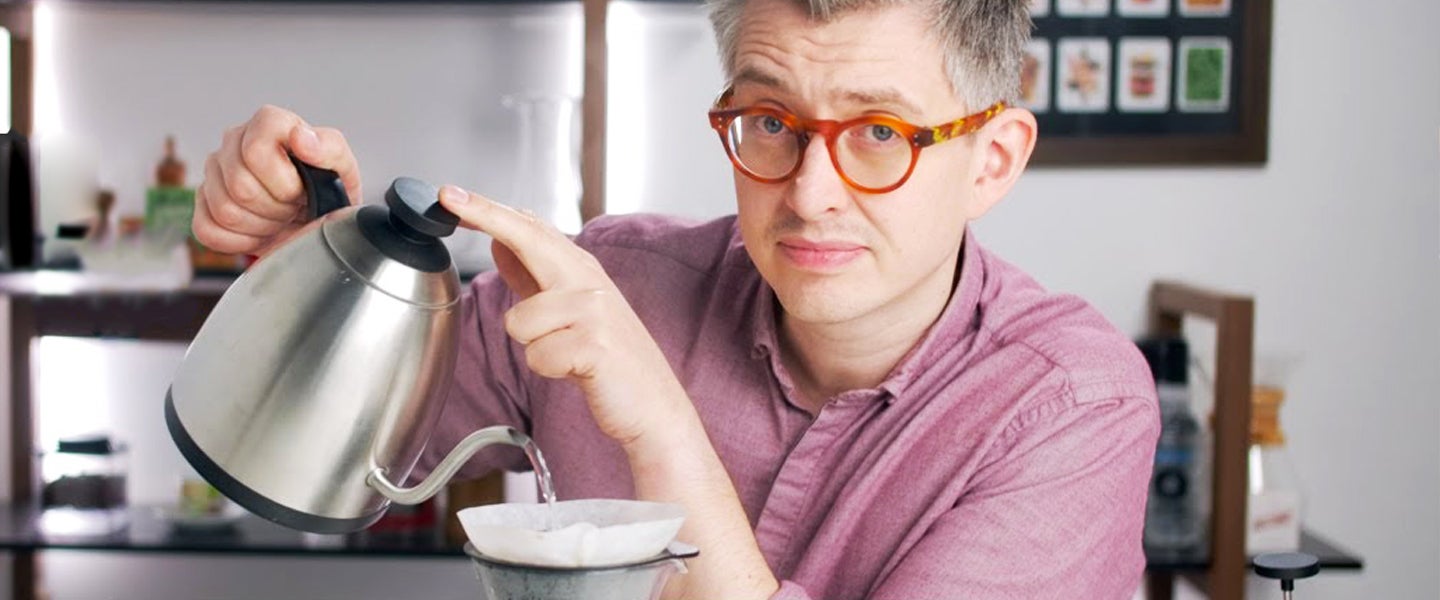Before lockdown, I never thought much about coffee. As long as it kept my eyelids open, it could have tasted like hot piss and I probably wouldn’t have noticed. But then — with nowhere to go but down YouTube wormholes — I stumbled upon James Hoffmann’s quick guide to making coffee with a French press.
His advice is simple: Use a clean press, freshly ground beans and filtered soft water. More importantly, be patient — very, very, very patient. By leaving the coffee to brew in the press for four minutes and then, as he says in his crisp, refined English accent, doing “absolutely nothing” for another five minutes before softly inserting the plunger (“but don’t go all the way”), he ensures that you get a smoother, more refined cup of Joe, with none of the bitter sediment (not to mention, at a temperature where you can actually drink it).
After trying his method, I was both hooked on how much better my morning brew tasted and Hoffmann’s YouTube content more largely — a quirky and unexpected journey into coffee culture (which, again, I previously could have cared less about). Because while Hoffmann might sound (and look) like the kind of snobby guy who runs a trendy coffee shop in East London, his 300,000-subscriber-strong channel does a remarkable job of removing the the pretentious bullshit generally associated with the coffee world.
Hoffmann, who is a founder of the British coffee company Square Mile, has been in the java business for close to two decades, competing in coffee-roasting competitions, winning multiple awards and writing a successful coffee blog. He started his YouTube channel back in 2014 when he noticed that “there were few people talking about coffee in a meaningful way,” and little in the way of coffee video content beyond people showing off their “coffee routines.” “Coffee is a huge industry, and a huge part of so many people’s lives,” he says. “But compared to food, there’s just not that much online.”
Hoffmann’s passion for coffee informs his belief that everyone should have the ability to make a great cup with whatever they have — whether it’s a high-end espresso machine, a V60 drip filter or Instant Coffee (though he admits it’s extremely hard to brew Instant Coffee well). Sometimes, it’s a matter of making sure that the coffee-to-water ratio is balanced; other times, it’s about understanding the science (for example, why a “swirling” technique for blooming filtered coffee is more effective at releasing carbon dioxide during an initial pour-over phase than using a spoon or letting it rest naturally).
In almost all cases, though, Hoffmann emphasizes that it’s patience — the quiet waiting and gentle pouring — that reaps the true rewards. “Pour slowly, and pour carefully,” he instructs in one tutorial. “Pour too aggressively, and you’ll disrupt the coffee bed and you won’t be able to extract the flavors.”
The comments section of his videos are a mix of aficianados discussing the minutiae of coffee grinding or temperature modification and those such as myself — newbies for whom Hoffmann’s passion and calming voice proves soothing no matter our lack of coffee knowledge. “I have absolutely no interest in coffee whatsoever. im a dr pepper guy,” a commenter wrote beneath a video in which Hoffmann reviews a Chemex brewing flask [sic, obviously]. “Yet your videos are so engaging, passionate and well informed, and you have such an agreeable manner.”
“I’ve never pulled an espresso shot in my life, and probably never will, but I still love watching James talk about espresso machines,” offered another in conjunction with a review of a device (an espresso profiler) even the most devoted coffee drinkers have probably never seen.
All of which brings me to the real task at hand: How can I make sure my quarantine coffee is as good as it possibly can be?
A few ways, Hoffmann instructs. For starers, I should “grind [my] own coffee beans for a cleaner flavor.” (Plus, he adds, “grinding them in the morning before brewing is an undeniable delight and better value long-term” compared to pre-ground or Instant Coffee.) When it comes to brewing, Hoffmann says, “A lot of people try to fix a weak cup of coffee by using more grounds, when the issue is often that they just didn’t get all the flavor out of the grounds they were using. Adding more coffee will make the cup stronger, but not better.”
Finally, Hoffmann gives me the most difficult piece of advice of all: Try to cut down on the amount of caffeine I drink. “Everyone has different tolerances, and there are genetic differences in the way that people metabolize caffeine,” he explains. “If you feel weird, add a bit of good quality decaf into your day, and you can have the best of both worlds!”
I’ll drink to that.

